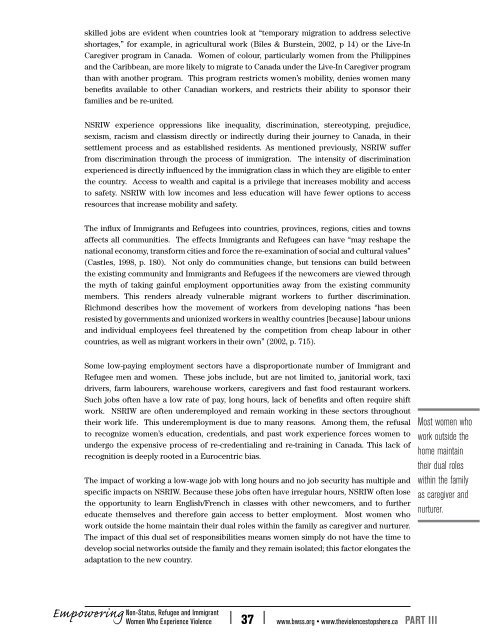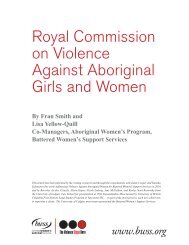migration-immigration-settlement
migration-immigration-settlement
migration-immigration-settlement
You also want an ePaper? Increase the reach of your titles
YUMPU automatically turns print PDFs into web optimized ePapers that Google loves.
skilled jobs are evident when countries look at “temporary <strong>migration</strong> to address selective<br />
shortages,” for example, in agricultural work (Biles & Burstein, 2002, p 14) or the Live-In<br />
Caregiver program in Canada. Women of colour, particularly women from the Philippines<br />
and the Caribbean, are more likely to migrate to Canada under the Live-In Caregiver program<br />
than with another program. This program restricts women’s mobility, denies women many<br />
benefits available to other Canadian workers, and restricts their ability to sponsor their<br />
families and be re-united.<br />
NSRIW experience oppressions like inequality, discrimination, stereotyping, prejudice,<br />
sexism, racism and classism directly or indirectly during their journey to Canada, in their<br />
<strong>settlement</strong> process and as established residents. As mentioned previously, NSRIW suffer<br />
from discrimination through the process of im<strong>migration</strong>. The intensity of discrimination<br />
experienced is directly influenced by the im<strong>migration</strong> class in which they are eligible to enter<br />
the country. Access to wealth and capital is a privilege that increases mobility and access<br />
to safety. NSRIW with low incomes and less education will have fewer options to access<br />
resources that increase mobility and safety.<br />
The influx of Immigrants and Refugees into countries, provinces, regions, cities and towns<br />
affects all communities. The effects Immigrants and Refugees can have “may reshape the<br />
national economy, transform cities and force the re-examination of social and cultural values”<br />
(Castles, 1998, p. 180). Not only do communities change, but tensions can build between<br />
the existing community and Immigrants and Refugees if the newcomers are viewed through<br />
the myth of taking gainful employment opportunities away from the existing community<br />
members. This renders already vulnerable migrant workers to further discrimination.<br />
Richmond describes how the movement of workers from developing nations “has been<br />
resisted by governments and unionized workers in wealthy countries [because] labour unions<br />
and individual employees feel threatened by the competition from cheap labour in other<br />
countries, as well as migrant workers in their own” (2002, p. 715).<br />
Some low-paying employment sectors have a disproportionate number of Immigrant and<br />
Refugee men and women. These jobs include, but are not limited to, janitorial work, taxi<br />
drivers, farm labourers, warehouse workers, caregivers and fast food restaurant workers.<br />
Such jobs often have a low rate of pay, long hours, lack of benefits and often require shift<br />
work. NSRIW are often underemployed and remain working in these sectors throughout<br />
their work life. This underemployment is due to many reasons. Among them, the refusal<br />
to recognize women’s education, credentials, and past work experience forces women to<br />
undergo the expensive process of re-credentialing and re-training in Canada. This lack of<br />
recognition is deeply rooted in a Eurocentric bias.<br />
The impact of working a low-wage job with long hours and no job security has multiple and<br />
specific impacts on NSRIW. Because these jobs often have irregular hours, NSRIW often lose<br />
the opportunity to learn English/French in classes with other newcomers, and to further<br />
educate themselves and therefore gain access to better employment. Most women who<br />
work outside the home maintain their dual roles within the family as caregiver and nurturer.<br />
The impact of this dual set of responsibilities means women simply do not have the time to<br />
develop social networks outside the family and they remain isolated; this factor elongates the<br />
adaptation to the new country.<br />
Most women who<br />
work outside the<br />
home maintain<br />
their dual roles<br />
within the family<br />
as caregiver and<br />
nurturer.<br />
Empowering Non-Status, Refugee and Immigrant<br />
Women Who Experience Violence 37 www.bwss.org • www.theviolencestopshere.ca PART III




